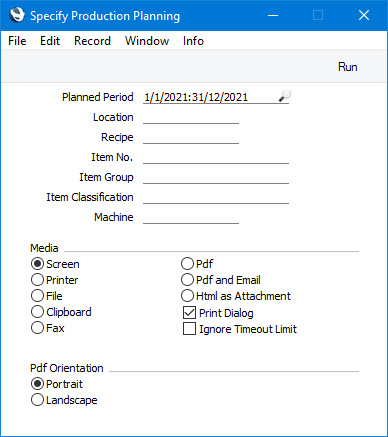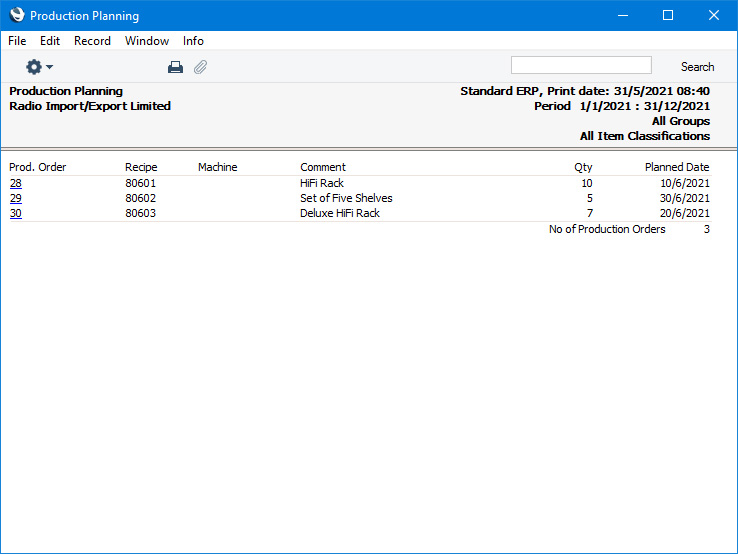Production Planning
This page describes the Production Planning report in the Production module.
---
The Production Planning report lists Production Orders whose Status is "Created". It therefore lists the Production Orders that have not yet been placed in a queue for a Machine.
For each Production Order, the report shows the Production Order Number, the Recipe, the Machine, the Name, the Quantity (from the Production Order header) and the Planned Date (the Should Start date).
When printed to screen, the Production Planning report has the Standard ERP Drill-down feature. Click (Windows/macOS) or tap (iOS/Android) on any Production Order Number to open an individual Production Order record.

- Planned Period
- Paste Special
Reporting Periods setting, System module
- Enter the start and end dates of the reporting period. Production Orders whose Status is Created and whose Should Start dates fall within this period will be listed in the report, as will Created Production Orders without Should Start dates.
- Location
- Paste Special
Locations setting, Stock module
- Enter a Location to list Started Production Orders that have been assigned to a particular Location (e.g. a particular workshop).
- Recipe
- Paste Special
Recipe register, Production module
- Enter a Recipe Number to list Created Production Orders that use a particular Recipe.
- Item No.
- Paste Special
Item register
- Enter an Item Number here if you need the report to list Started Production Orders in which the specified Item is the Output Item.
- Item Group
- Paste Special
Item Group register, Sales Ledger
- If you specify an Item Group here, the report will list Started Production Orders in which the Output Items belong to the specified Item Group.
- Item Classification
- Paste Special
Item Classifications setting, Sales Ledger
- Use this field if you need the report to list Started Production Orders in which the Output Items have a particular Item Classification. If you enter a number of Classifications separated by commas, only Production Orders in which the Output Items have all the Classifications listed will be included in the report. If you enter a number of Classifications separated by plus signs (+), Production Orders with Output Items featuring at least one of the Classifications listed will be included. If you enter a Classification preceded by an exclamation mark (!),Production Orders with Output Items featuring any Classification except the one listed will be included.
- For example:
- 1,2
- Includes Production Orders with Output Items with Classifications 1 and 2 (including Output Items with Classifications 1, 2 and 3).
- 1+2
- Includes Production Orders with Output Items with Classifications 1 or 2.
- !2
- Includes Production Orders with Output Items that do not have Classification 2.
- 1,!2
- Includes Production Orders with Output Items with Classification 1 but not Classification 2. Note the comma before the exclamation mark in this example.
- !1,!2
- Includes Production Orders with Output Items that do not have Classification 1 or 2 or both. Again, note the comma.
- !(1,2)
- Includes Production Orders with Output Items that do not have Classifications 1 and 2 (Output Items with Classifications 1, 2 and 3 will not be included).
- !1+2
- Includes Production Orders with Output Items that do not have Classification 1 but do have Classification 2 (Output Items with Classifications 1 and 2 will be included).
- (1,2)+(3,4)
- Includes Production Orders with Output Items with Classifications 1 and 2 or Classifications 3 and 4.
- 1*
- Includes Production Orders with Output Items with a Classification beginning with 1 (e.g. 1, 10, 100).
- 1*,!1
- Includes Production Orders with Output Items with a Classification beginning with 1 but not 1 itself.
- *1
- Includes Production Orders with Output Items with a Classification ending with 1 (e.g. 1, 01, 001).
- 1*,*1
- Includes Production Orders with Output Items with a Classification that begins and ends with 1 (e.g. 11, 101, 1001).
- Machine
- Paste Special
Asset register, Assets module
- Enter a Machine Number to list Started Production Orders that have been assigned to a particular Machine.

---
Go back to:
